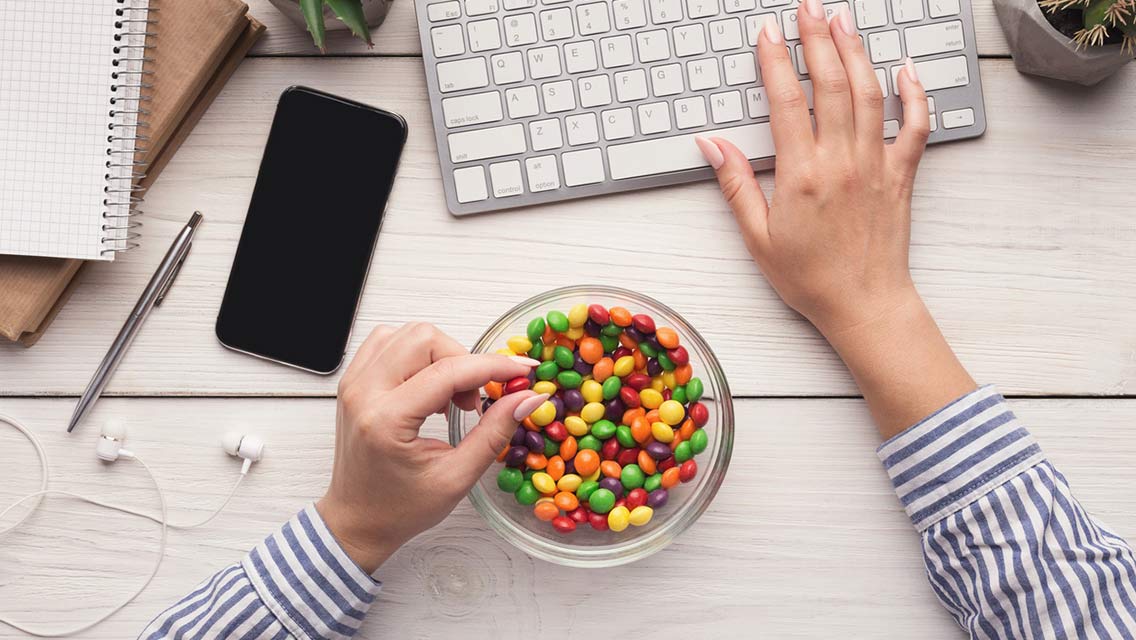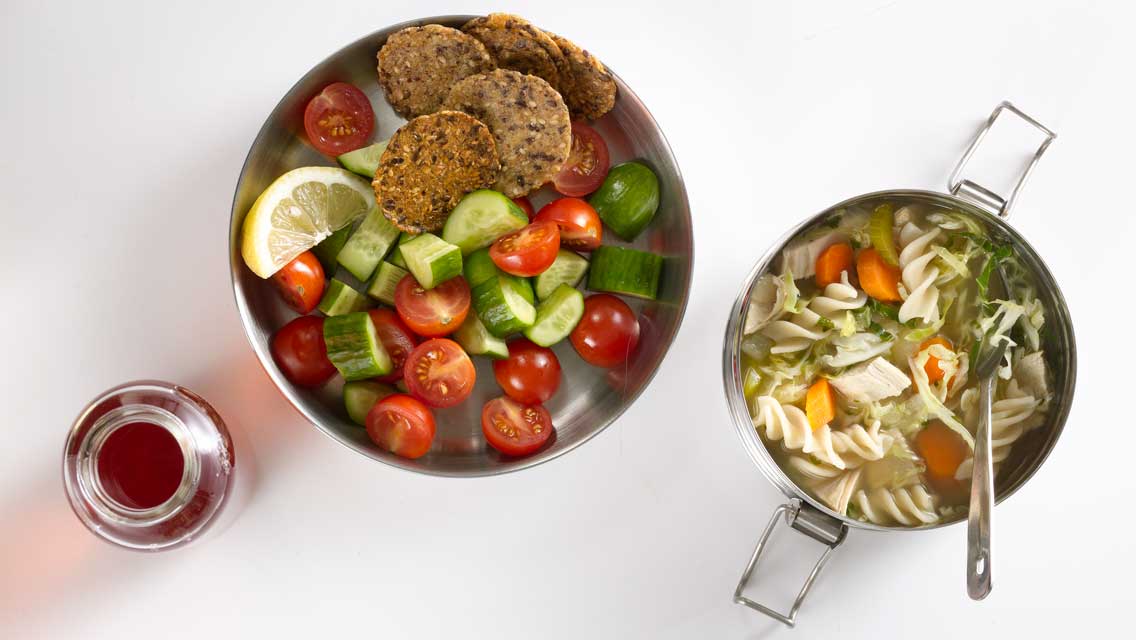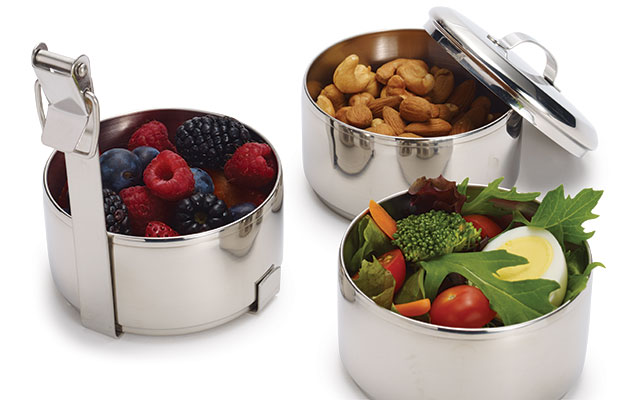One day you decide that it’s high time you started eating healthier. The next week at work, you’re confronted with reality: catered buffet-style lunches in the conference room, client dinners on the town, takeout meals eaten on the run or gobbled at your desk — all of which may tend to make your dedication to healthy eating seem like a foggy, out-of-context memory. Plus, with all the professional challenges and obligations you’ve got on your proverbial plate, what’s on your actual plate may seem like the least of your concerns.
“In a stressful work environment, it’s easy to allow yourself to get so hungry that you’re likely to just grab or order anything without thought,” says Keri Gans, MS, RD, a spokesperson for the American Dietetic Association.
It’s in moments like these that you convince yourself that an Almond Joy makes an OK lunch. (There’s protein in those nuts, right?) Or that the giant platter of hoagies in the conference room is just what your soul needs for soothing.
But opting for quick, nutritionally empty fixes will only leave you back at your desk, feeling woozy, lethargic, or in need of a shot of sugar or caffeine — and still as stressed-out and badly nourished as you were before you ate.
Here, we run through three common work-related eating scenarios — the catered lunch, the client dinner, a grab-and-go meal — and spell out preparatory tips and effective on-site strategies that make eating at work both healthier and more enjoyable than the lowest-common-denominator choices you’ve been settling for up until now.
1. Catered Lunches
The Scene:
In a white-walled conference room, a folding table temporarily converted to a buffet line groans with pans of baked ziti and greasy-looking breaded chicken Parmesan. A chopped-lettuce salad appears to be the only veggie not swimming in some kind of mystery sauce. Dessert is the only appealing offering — a plate of oatmeal cookies, approximately the size of hubcaps. It’s not a pretty set of choices. Here are a few suggestions for making the best of a bad situation.
The Strategy:
Don’t go in famished. If you anticipate a catered meal, and are unsure of what might be awaiting you in the buffet line, prepare accordingly. Eat a healthy snack from your desk ahead of time (see “Go-To Snacks,” below) so you aren’t compelled to make a beeline for the first thing that looks remotely edible. From there, use the following ideas to make the best choices possible, and plan to enjoy a healthy snack later, if you’re still hungry.
Get focused. As you enter the room, take a moment to center yourself. “Before you start making selections, take three deep breaths as a gentle reminder of your intention to be healthy,” suggests Kathie Swift, MS, RD, LDN, lead nutritionist at the Kripalu Center for Yoga and Health in Stockbridge, Mass., and chief nutrition adviser for MyFoodMyHealth.com. Make your goal not about perfection or “being good,” she advises, but about “practicing responsible freedom with food.” Next, survey the entire buffet from an objective standpoint to identify the two or three things you can actually eat. If you simply pick up a plate and start in at the beginning of the buffet line, you might end up with a plateful of ziti and no room for the relatively decent green salad at the other end of the table. So peruse, then pick.
Be selective and creative. Don’t let what’s served as the “main course” dictate what you put at the center of your plate. You can always put the tomato-based pasta sauce over the grilled veggies, sans pasta, or use it as a dip for raw veggies. If sandwiches are served, and the bread is a ridiculously large portion, eat yours open face. Remove excess cheese slices and replace them with extra vegetables or salad greens. Or if the fillings look good, grab two and ditch the bread entirely, chopping up the insides and laying them over a large plate of greens and veggies to make a custom salad. You can fairly easily scrape the exterior crusts off of fried meat cutlets and eggplant Parmesan, for example (just grab an extra napkin onto which you can scrape that stuff), and add the insides to your salad or veggie plate. If dessert is nothing special (typically the case), skip it and grab a cup of tea or bowl of fruit instead. If you really want a small serving of dessert, instead of operating from a deprivation mindset, just be moderate: Using a napkin, break one of those cookies in half, or even in quarters. The person behind you will probably thank you.
Seat yourself wisely. If you know you’re going to be offloading the white-bread wrapping and bacon from your turkey wrap, plucking noodles out of your soup, scraping breading off your cutlet or extracting croutons from your salad, grab a seat near the garbage can or near the buffet line. That way, once you’ve discreetly deconstructed your eats and opened up more room on your plate, you can inconspicuously throw away what you don’t want and create space for a little more of whatever looks edible.
Make it a learning opportunity. If meals like this regularly occur at your place of work, make a point of politely approaching the person in charge of the meal, expressing appreciation for his or her efforts, and asking if some healthier options could be made available in the future. Be specific: Suggest the addition of a more colorful mixed-greens salad; some raw, grilled, steamed or otherwise simply prepared vegetables; a broth or bean-based soup; a protein choice that’s not deep-fried and swimming in oil; perhaps a vegetarian entrée option. Given that most companies are trying to reduce their healthcare costs, your feedback might end up creating a win-win for all involved.
2. Dining Out
Even though the days of three-martini lunches are over (at least everywhere but on Mad Men), a meal at a nice restaurant with a work colleague or client can still present significant challenges and temptations. Caught up in the spirit of the moment, you can easily end up consuming all kinds of dishes you’d never normally consider, plus a huge hunk of cheesecake and three glasses of wine. You’ve already heard the advice to avoid the breadbasket and drink lots of water; also consider the advice below.
The Strategy:
Start the day full. You usually know beforehand when you’re going to eat out, so if you’re having a client lunch, start the day right with a breakfast that features healthy proteins and complex carbohydrates, both of which take longer to digest and promote a feeling of satiety. “On days I have business lunches scheduled, I have go-to breakfasts,” says Lisa Delaney, author of Secrets of a Former Fat Girl (Plume, 2008) and editor-in-chief of a health and wellness magazine, Spry. She also takes care with the other meal still within her control: “For dinner, I make sure I have a good portion of protein and green veggies.”
Choose your spot. “Most people don’t want the responsibility of selecting where to eat,” says Courtney Angeli, an employment lawyer in Portland, Ore., who eats out a couple of times a week with clients. “So I seize the opportunity to pick a place where I’m familiar with the menus and know I can make good choices.” If you’re concerned about appearing too demanding or picky, give your guest two or three options, all of which have a diverse selection of foods on the menu.
Do some advance research. If possible, examine the menu online before you head out. That way, you won’t need to divert your attention from an important conversation to make sense of what’s being offered.
Ask for what you want. Don’t be shy about fine-tuning your order by subbing out any ingredients that don’t agree with you, requesting a simpler preparation, asking for more or less of certain dishes, or simply rightsizing your plate. For example, says Angeli, “Sometimes I’ll just ask for a two-thirds portion.” That way, she explains, you avoid asking the awkward “Can you bag up half of this?” pre-meal request. As long as your requests are reasonable and made with courtesy, they’ll come across as discerning, not fussy. “Being a healthy eater shows you care about yourself,” says Gans. “It’s the same as being a diligent worker; it’s a trait you’d want in a business relationship.”
Keep your meal simple. The chef’s special may sound absolutely amazing, but if you order a no-nonsense plate of grilled fish, rice and sautéed greens, you’ll probably have far less to worry about nutritionally, and a much greater opportunity to focus on your dining companions. “The simpler the preparation is, the less likely it is to weigh you down or distract you,” says Marissa Lippert, MS, RD, who owns Nourish, a consulting company in New York City. Angeli agrees: “I don’t want to be excessively focused on my food,” she notes. “The conversation is supposed to be the centerpiece.”
Have a first course. A plate of fresh greens is a nutrient-rich way to start any meal. It will blunt your hunger and ensure that you get some vegetables even if the entrée’s serving is light. The safest dressing choice is the one you mix yourself at the table from extra-virgin olive oil and balsamic vinegar (the commercial dressings served in restaurants are often chock-full of trans fats, high-fructose corn syrup and various additives). Even if the house dressing is actually made in house, ask to have it served on the side. Another good, light appetizer: a bean- or broth-based soup rather than a heavy bisque or chowder.
If you drink, drink moderately. Ordering a glass of wine, if your companions are also drinking, can be an enjoyable complement to your meal. Yet, any amount that alters your behavior or slows your thinking is obviously not in your best interest — and is also a sugar-heavy source of empty calories that will keep your liver working overtime. Plus, having even one drink too many can impair your judgment, inclining you to overeat in a big way.
Decide in advance how many drinks you’ll have so that you can pace yourself. Or, decide not to drink at all. Jeff Klem, vice president of organizational development for Healthways, a Franklin, Tenn.–based healthcare support firm, notes that during many of his work dinners, some people drink and some don’t: “There certainly isn’t an expectation one way or the other.”
If you’re going to have a drink, try to stick with wine or beer, as opposed to hard liquor, and sip slowly over the course of your meal. Limit yourself to no more than one drink per hour-and-a-half conversation, and no more than two drinks, total, for an evening.
4. The Grab-and-Go Meal
The Scene:
You’re getting too famished to concentrate, but still have a lot of work left to complete before the end of the day. Or you have just a few minutes to eat something before the beginning of a meeting that is sure to drag on for at least two hours — so if you don’t feast now, it’s a guaranteed famine. Here’s how to squeeze in some decent nourishment, whether you’re hungry for lunch, snacks or a working-late dinner.
The Strategy:
Feed your inner second-grader. Whenever Delaney is eating under pressure, she remembers what she put in her son Johnny’s lunch when she sent the second-grader off to school that morning. “I pack him foods that aren’t messy and are healthy and varied and can be eaten quickly.” Delaney packs her own lunch with those priorities in mind, and on days she neglects to bring her lunch or needs to fill in with a quick snack, she heads to the deli to play catch-up, grabbing a yogurt, half of a sandwich, a piece of fruit and maybe a string cheese. “That way, I can pick and choose from a variety of foods depending on my hunger level,” she explains.
Step away from the keyboard. No matter how busy you are, plan your fuel breaks so that you don’t eat in front of a computer monitor. Eat at a spot other than your desk — a park bench, the company cafeteria — so that you physically remove yourself from visual cues of to-do lists and stress. If that’s not possible, Swift suggests bringing a place mat and putting it on a far corner of your desk. Then prepare to eat consciously. “Before you begin, engage your senses,” she suggests. “What does your meal smell and look like? What’s your intention for this meal? Leave your work alone as you dine, so you can do your best to make it a nourishing experience.”
Eat international. Ethnic foods are often more focused on veggies, lean meats and legumes, and they can be quite healthy — if you make the right choices. Avoid anything battered, fried or served swimming in sauce. Instead, choose veggie stir-fries; broth-based soups, like egg-drop, Tom Yum or hot and sour (first ask if the restaurant uses MSG in these preparations, though!); grilled or broiled meats, like tandoori chicken or shish kebob; and anything legume-based, like hummus or baba ghanoush. Plan to eat only a small helping of rice or couscous, not the entire container. If you can, grab a pair of chopsticks to replace your fork. They’re not only a fun switch, but they’ll naturally slow you down, giving your head a chance to listen to your stomach.
Mix and match. Use healthy, easy-to-transport items from home to round out your takeout meals. Keep a bag of prewashed leafy greens in the office fridge and grab a grilled chicken breast or poached salmon or tofu stir-fry at a local eatery to layer on top of it. Or try the reverse: Bring dinner leftovers from home, then pick up a fresh salad of veggies and legumes to lay underneath. For your postmeal sweet tooth, pack something satisfying, like a couple of dark chocolate squares, so that you’re not tempted to overdose with an entire chocolate bar, blended coffee drink or store-bought dessert.
Find a healthy chain. Many quick-serve restaurants catering to today’s busy crowds serve create-your-own salads, stir-fries, burrito “bowls,” or soups made primarily from fresh, whole foods. Scout out a few of these operations within range of your office. Even if it means driving (or walking, or biking) a mile or two, knowing they are there may make you less tempted to grab a greasy cheeseburger or pizza from the place just down the street.
Of course, there will always be days when a buffet line or box lunch gets the better of you, or when a chef’s special proves too much to resist. You can’t always eat perfectly at work. But by adopting healthy-eating tactics like these more often, you can manage your work-related nutrition as capably as you handle the rest of your job. And who knows? With all the energy and vitality you’ll enjoy as a result, your job just might start to seem a little easier.
Go-To Snacks
Keeping a stash of healthy snacks in your desk drawer or your office fridge helps you defend yourself against bad buffet lunches and afternoon vending-machine trips. Having at least two healthy snacks a day also keeps your blood-sugar level and your appetite in check. If you typically have breakfast around 7 a.m., for example, plan to have a snack about 10, so you’re not famished when lunch rolls around. Then grab another snack around 3 or 4 so you won’t be tempted to eat less healthy treats on the way home. Try the items below for starters, and combine at will.
- Nuts and seeds: Almonds, walnuts, pecans, and sunflower and pumpkin seeds are protein-packed and easy to store at your desk or in your office refrigerator.
- Single servings of plain or vanilla yogurt.
- Any kind of fruit: apple, orange, pear, banana, grapefruit, mango, etc. Organic Turkish figs or other dried fruit can help satisfy a sweet tooth.
- Nutrition bars made mainly from whole foods (choose those free of hydrogenated fats and corn syrups and containing only a few simple ingredients).
- Whole-grain, seeded crackers and a tub of hummus.
- Hard-boiled eggs you can store in the refrigerator and nosh on throughout the week.
- A supergreen (e.g., spirulina, chlorella or barley grass) powder supplement or protein-rich drink mix you can blend with water and a little ice in a shaker.
- A Square or Two of dark chocolate (limit chocolate to a once-a-day treat and stick to varieties of 70 percent intensity or greater).
- A variety of teas. “Sometimes we think we need food,” says Swift, “but sipping a relaxing tea may be just as satisfying and rejuvenating.”
This article originally appeared as “Eating 9 to 5.”




This Post Has 0 Comments